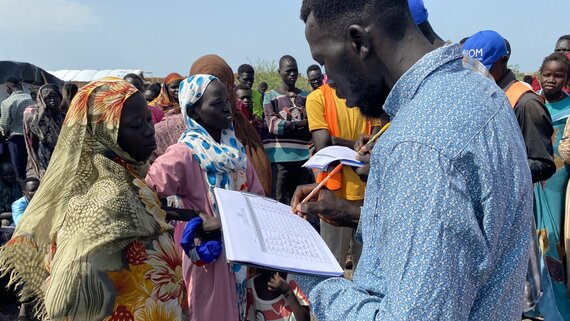Needs
As of October 2023, South Sudan hosts around 350,000 refugees and asylum-seekers, of whom 93 percent are Sudanese and the rest are of other nationalities. About 98 percent of refugees reside in over 11 camps and settlements across the country, with the remaining 2 percent in urban locations. Since the onset of the conflict in Sudan in April 2023, over 40,000 new refugee arrivals have been recorded. In 2024, a further 80,000 refugees are anticipated, mainly from Sudan.
People forced to flee Sudan face multiple protection risks during their flight as they seek safe pathways into South Sudan, arriving exhausted after days of travel. Upon arrival, refugees and asylum-seekers require immediate emergency assistance before onward travel to refugee camps or settlements. Life-saving assistance includes food, WASH, vulnerability and health screening, shelter, vaccinations for children, and psychosocial support. In 2023, vulnerability screening revealed one or more vulnerable individuals in every third household. Existing refugee camps and settlements will require expansion to accommodate new arrivals.
An increase in the population of refugee camps and settlements will limit the availability of essential services and assistance, including education, health, shelter, and WASH, exacerbating protection risks for the most vulnerable and leading to the deterioration of the well-being of the refugee population. A significant increase in the population will place additional pressure on resident communities, which require further support to promote peaceful coexistence.
Response
The Refugee Response Strategy ensures that the critical needs of refugees and asylum-seekers are met with context-specific and targeted interventions in close collaboration with the Government and other partners to maintain an enabling protection and solution-oriented environment. The strategy will be premised on the ‘whole of government’ and ‘whole of society’ approach to maximize the limited resources.
The Refugee Response Plan includes two key strategic objectives:
- Strengthening access to international protection and life-saving emergency services, and
- Supporting the resilience of refugees through development-oriented solutions in partnership with development and peacebuilding partners.
Partners have adopted a protection-centered approach in providing services and assistance to new arrivals from Sudan. The Government of the Republic of South Sudan will grant unimpeded access to its territory to people fleeing Sudan and maintain inclusive policies. Partners will support the Government in strengthening the civilian character of asylum, conducting border and protection monitoring, improving conditions of transit centers, ensuring proper documentation, providing emergency and life-saving services, assisting with onward transportation to refugee locations, and other multi-sectoral assistance.
Existing refugee camps and settlements will be expanded to accommodate new arrivals while increasing the capacity of the essential service providers to ensure humanitarian standards. This includes the provision of shelter, food, WASH, and health care. Emphasis will be placed on safeguarding the rights of the most vulnerable, including women, children, the elderly, and persons with disabilities. This will be achieved by preventing and responding to protection risks such as GBV and other forms of abuse and ensuring access to legal documentation, pathways, and systems.
Increased access to education opportunities for children and youth will promote self-reliance and long-term stability. Livelihood programs will be crucial for income-generating opportunities and reducing dependency on humanitarian aid. Partners will foster social cohesion and peaceful coexistence between refugees and resident communities.
UNHCR and its partners will promote the sustainable integration of refugees through enhancing policy and legal frameworks and supporting refugee resilience grounded on the humanitarian, development, and peace nexus. Partners will actively aim to shift the current assistance approach to empower refugees to fulfill their needs by building their resilience and community capacities.

Renk County, Upper Nile State, South Sudan.
A humanitarian worker recording details of South Sudanese returnees at Joda point of entry in Renk County in Upper Nile State.
OCHA/Iramaku Vundru WilfredMonitoring
The Refugee Response Plan includes a robust monitoring framework outlining key objectives, indicators, and data collection methods. Within the refugee coordination model, working groups will analyse the monitoring data to address gaps, and feedback mechanisms will guide response priorities. Data summarized from indicators will promote accountability and transparency, and partner training will improve data collection and reporting. Needs assessments and protection monitoring will consistently inform the response.
For more information on the refugee response, please click here

